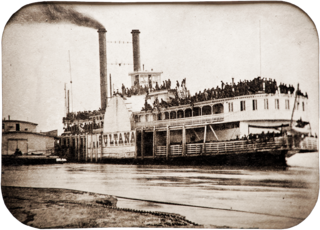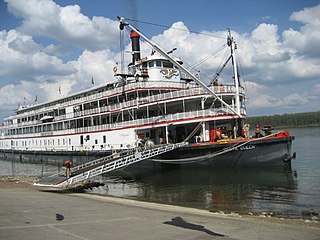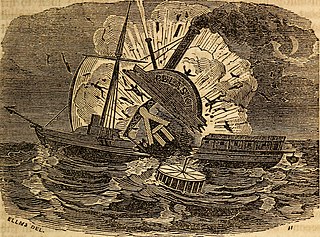Related Research Articles

The 1947 Texas City disaster was an industrial accident that occurred on April 16, 1947, in the port of Texas City, Texas, United States, located in Galveston Bay. It was the deadliest industrial accident in U.S. history and one of history's largest non-nuclear explosions.

Sultana was a commercial side-wheel steamboat which exploded and sank on the Mississippi River on April 27, 1865, killing 1,169 people in what remains the worst maritime disaster in United States history.

A boiler explosion is a catastrophic failure of a boiler. There are two types of boiler explosions. One type is a failure of the pressure parts of the steam and water sides. There can be many different causes, such as failure of the safety valve, corrosion of critical parts of the boiler, or low water level. Corrosion along the edges of lap joints was a common cause of early boiler explosions.

The Steamboat Inspection Service was a United States agency created in 1871 to safeguard lives and property at sea. It merged with the Bureau of Navigation in 1932 to form the Bureau of Navigation and Steamboat Inspection, which in 1936 was reorganized into the Bureau of Marine Inspection and Navigation. The Bureau of Marine Inspection and Navigation's responsibilities were transferred temporarily to the United States Coast Guard in 1942. The Bureau was abolished in 1946, when its functions were transferred permanently to the Coast Guard.

Steamboats on the Columbia River system were wrecked for many reasons, including striking rocks or logs ("snags"), fire, boiler explosion, or puncture or crushing by ice. Sometimes boats could be salvaged, and sometimes not.

Steamboats played a major role in the 19th-century development of the Mississippi River and its tributaries, allowing practical large-scale transport of passengers and freight both up- and down-river. Using steam power, riverboats were developed during that time which could navigate in shallow waters as well as upriver against strong currents. After the development of railroads, passenger traffic gradually switched to this faster form of transportation, but steamboats continued to serve Mississippi River commerce into the early 20th century. A small number of steamboats are still used for tourist excursions in the 21st century.

The Lucy Walker steamboat disaster was an 1844 steamboat accident caused by the explosion of the boilers of the steamboat Lucy Walker near New Albany, Indiana, on the Ohio River. The explosion occurred on the afternoon of Wednesday, October 23, 1844, when the steamer's three boilers exploded, set the vessel on fire, and sank it. It was one of a number of similar accidents of early 19th-century riverine transportation that led to important federal legislation and safety regulations. The vessel's owner was a Native American; her crew were African-American slaves, and her passengers represented a cross-section of frontier travelers.

The river sternwheeler Ramona operated from 1892 to 1908 on the Willamette River in Oregon, on the Stikine River running from Wrangell, Alaska into British Columbia, and the Fraser River, in British Columbia. This vessel should not be confused with the coastal steamship Ramona which also ran in Alaskan waters.

The Moselle was a riverboat constructed at the Fulton shipyard, in Cincinnati, Ohio. between December 1, 1837 and March 31, 1838. The Moselle was considered one of the fastest river boats in operation at the time, having completed a record-setting two-day, sixteen-hour trip between Cincinnati and St. Louis. On April 25, 1838, the Moselle, piloted by Captain Isaac Perin, suffered a boiler explosion just east of Cincinnati, killing 160 of the estimated 280–300 passengers. The boat had just pulled away from a dock near the neighborhood of Fulton, when all four boilers simultaneously suffered a catastrophic failure resulting in the total destruction of the ship from the paddlewheels to the bow. The ship drifted approximately 100 yards before sinking to the bottom of the Ohio river. Negligence may have been a factor in the explosion: many eyewitness reports claimed that Captain Perin had been racing another riverboat, the Ben Franklin (1836) at the time of the explosion, and therefore the pressure in the boilers was excessively high.

Sarah Dixon was a wooden sternwheel-driven steamboat operated by the Shaver Transportation Company on the Columbia and lower Willamette rivers from 1892 to 1926. Originally Sarah Dixon was built as a mixed use passenger and freight vessel, and was considered a prestige vessel for the time.

James T. Staples, officially registered as the Jas. T. Staples and also known as the Big Jim, was a Tombigbee River sternwheel paddle steamer that ran a route between Mobile and Demopolis, Alabama, during the early 20th century. She was destroyed during 1913 in an explosion while docked on the Tombigbee roughly six miles (10 km) north of the current Coffeeville Lock and Dam. It was the last major maritime disaster involving a steamboat in Tombigbee River history. The disaster saw the ship enter southwestern Alabama folklore, with tales that its sinking had been foretold by supernatural occurrences.
Helen McGregor may refer to:
The Lioness was a steamboat that exploded on the Red River of the South on the morning of May 19, 1833.

The Steamship Pulaski disaster was the term given to the June 14, 1838, explosion on board the American steam packet Pulaski, which caused her to sink 30 miles off the coast of North Carolina with the loss of two-thirds of her passengers and crew. About 59 persons survived, and 128 were lost. Her starboard boiler exploded about 11 p.m., causing massive damage as the ship was traveling from Savannah, Georgia, to Baltimore, Maryland; she sank in 45 minutes.

Senator was a stern-wheel-driven steamboat which operated on the Willamette River in the state of Oregon from 1863 to 1875. Senator is chiefly remembered for its having been destroyed in a fatal boiler explosion in 1875 while making a landing at the Portland, Oregon waterfront in 1875.
The Indiana State Fairgrounds Coliseum gas explosion took place in Indianapolis, Indiana, United States, on October 31, 1963; 81 people died and about 400 others were injured. It was one of the worst disasters in the history of both the city and the state.

The Louisiana was a Mississippi River steamboat that exploded on November 15, 1849, killing at least 150 and possibly as many as 200 people, and grievously wounding scores of others. All of the boilers exploded simultaneously about five minutes after she pulled away from the dock at Gravier Street in New Orleans; the entire boat sank 10 minutes after the explosion. Several of the dead were on the steamer Storm, which was docked adjacent to the Louisiana.

The Ben Sherod was an American steamboat that caught fire and then exploded on May 8, 1837, about 30 mi (48 km) south of Natchez, Mississippi. The fire ignited explosions of barrels of whiskey and brandy, and 39 barrels of gunpowder. The ship's boilers ultimately blew up as well. An estimated 175 lives were lost of roughly 225 aboard. She had been steaming from New Orleans to Louisville.
References
- 1 2 Howland, S. A. (1846). "Explosion of the Helen M'Gregor". Steamboat disasters and railroad accidents in the United States. Worcester: W. Lazell. pp. 127–132.
- 1 2 Lloyd, James T. (1856). Lloyd's steamboat directory, and disasters on the western waters. Cincinnati, O.: J.T. Lloyd & Co. pp. 69–73.
- ↑ Scharf, John Thomas (1883). History of Saint Louis City and County: From the Earliest Periods to the Present Day: Including Biographical Sketches of Representative Men. L. H. Everts. p. 1108.
- ↑ Hubbell, Daniel (2018-01-29). "Subchapter M Is The Latest In A Series Of Marine Regulatory Systems". The Waterways Journal. Retrieved 2023-06-28.